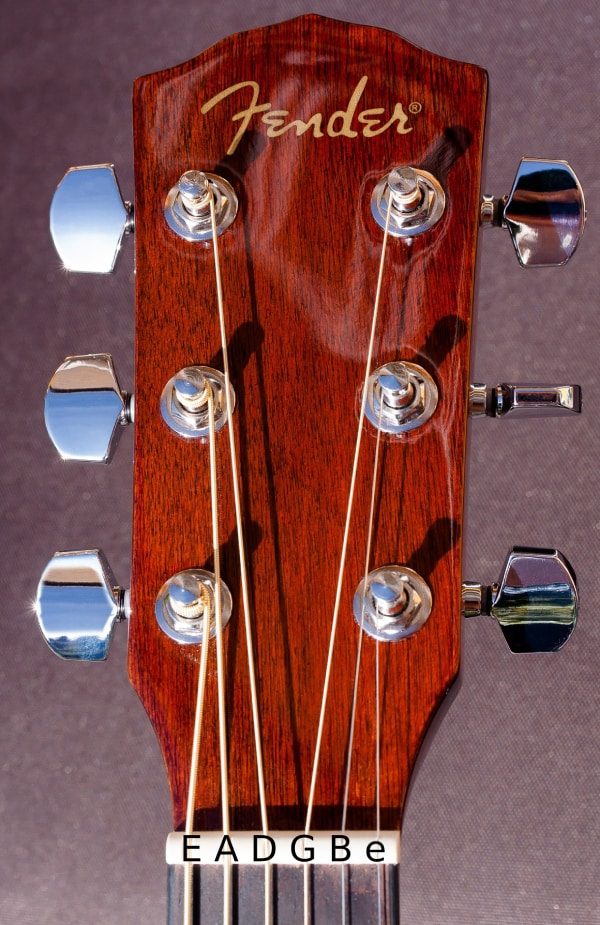
An easy guide to standard guitar tuning
By
Oli Braithwaite

This guide will enable you to tune your acoustic, electric or classical guitar in a jiffy, no matter what type of tuner you have, or even if you don’t have one at all.
What is standard guitar tuning?
 When we talk about “standard guitar tuning” we’re referring to the most commonly accepted technique for tuning a six string guitar. (What good is your guitar if it’s not in tune, right? Exactly.)
When we talk about “standard guitar tuning” we’re referring to the most commonly accepted technique for tuning a six string guitar. (What good is your guitar if it’s not in tune, right? Exactly.)
Standard guitar tuning is defined as the string pitches of E – A – D – G – B – e and is arranged from the lowest pitch to the highest pitch with the little e denoting the highest pitch on the thinnest string (the 1st string).
See the accompanying image for a visual representation of the standard tuning notes against the strings.
You’ll find that guitarists have created variations of this called ‘alternative’ or ‘alternate’ tuning, but standard guitar tuning is the norm and the best place to start.
Standard guitar tuning by ear
Standard guitar tuning by ear doesn’t require an electronic tuner, but you need to listen really carefully to a recording such as the one in this video, or pitch pipes (old school), to tune your guitar.
It’s worth saying up front that this method of tuning is not as easy as tuning with an electronic tuner, it often results in less tuning accuracy and you can’t do it without something to provide the notes… but it can also be a life-saver.
- First, you’ll need to find a solid tuning source if you want to tune by ear. This could be an audio recording, pitch pipes, another instrument or a video like the one above that’s specifically designed for tuning.
- Begin by tuning the 6th string (the thickest one) to the note E. Pluck it to make a sound. If it’s not the same pitch as the sound on the tuning audio or video, make a very small adjustment on the tuning peg until it matches the note exactly.
- Next, pluck the 5th string (next thickest one) to tune it until it sounds the same as the A note.
- Do the same on the remaining strings. Hey presto, you’re done.
Standard guitar tuning by electronic tuner
Tuning with an electronic tuner, also known as a digital tuner, is perfect for beginners because it’s the easiest method that offers the most accuracy.
Gear note: you’re going to have to get yourself an electronic tuner if you want to tune your guitar this way. Some electric-acoustic guitars have a built-in electronic tuner that operates the same way as a standard electronic tuner. Alternatively, there are some good free and paid tuner apps available for smartphones.
To tune your guitar using an electronic tuner, simply follow the steps below.
- Make sure that the tuner is set to 440 Hz (the standard tuning frequency).
- Pluck each string from the 6th to the first and ensure that the tuner is naming them E, A, D, G, B and E with no sharp # or flat ♭ symbols. If there’s a sharp symbol, lower the tone of the note until the symbol disappears and if there’s a flat symbol, raise the tone of the note.
- Once the tuner is showing the correct name for each of the strings, you can begin fine-tuning them one by one using the tuning key, until the needle on the display is in the middle (they often go green at this point).
- Once done, repeat! Continue until each string is perfectly in tune.
Standard guitar tuning with a tuning pedal
A tuning pedal is an accessory you connect to your pedal chain, to make it really easy to tune your electric guitar when playing.
Here’s how tuning with a pedal works:
- Connect your electric guitar to the input jack. This turns on the power.
- Press the pedal switch to engage the tuner pedal.
- Play a single note on your guitar, and tune it (in the same way as described for electronic tuners above).
- Note that the sound from the output jack is muted when the tuner pedal is engaged.
Standard guitar tuning by the fifth fret method
This method is a little more advanced but doesn’t require you to have an electronic tuner, recording or a piano so it enables you to tune your guitar anywhere any time.
Ideally, you’ll need to have at least one of your strings in tune in order to carry this out, if not your guitar will sound fine by itself but may be out of tune with other instruments.
Here’s what you do to tune by the fifth fret method:
- Play the fifth fret of the 6th string and the play the 5th string open. Let both the two notes ring together. Their pitches should match exactly. If they don’t, determine whether the 5th string is higher or lower pitched. If the 5th string seems lower (flat) turn its tuning peg to raise the pitch. If the 5th string seems higher (sharp), use its tuning peg to lower the pitch.
- Now that the 5th string is in tune, you can use it to tune the 4th string against. It’s the same process as before, play the 5th fret on the 5th string and play the 4th string open, and then turn the pegs on the 4th string until the pitches match.
- Next play the 5th fret on the 4th string and then play the 3rd string open and repeat the tuning process.
- Pay attention on this one as you need to play the 4th fret on the 3rd string instead of the 5th fret. Pluck the 4th fret on the 3rd string and then pluck the 2nd string open and proceed with the tuning process.
- Lastly, go back to the 5th fret of the 2nd string and the play the 1st string open, then tune it.
Standard guitar tuning by harmonics
Similar to the fifth fret method, tuning by harmonics requires you to have at least one string in tune if you wish to play with other instruments.
What’s a harmonic?
Harmonics are high pitched notes that are produced using a different technique to the normal fretting and plucking of a guitar string. Harmonics can contain much higher notes than the standard playing of frets allows and their tone is very different too, sounding more like a synthesiser than a guitar.
How do you play a harmonic on guitar?
The goal is to cause the string to vibrate in two sections either side of the place you touch the string. To achieve this, don’t press the string down onto the fret. Instead, lightly touch the string directly above the wire of the fret as you pluck the string, then pull your finger away once you feel the vibration.
If you don’t kill the string’s vibration entirely and you’re in the right place (not all frets work), you will play a harmonic.
It’s worth noting that harmonics are much easier to play on electric guitars played through an amp than acoustic guitars.
Now you know how to play a harmonic, here’s how to tune with harmonics:
- If you intend to play with other musicians, make sure the 6th string is tuned to E.
- Play the harmonic on the 5th fret of the 6th string then play the harmonic on the 7th fret on the 5th string. Make the corresponding adjustment on the tuning pegs of the 5th string until the two match.
- Play the harmonic on the 5th fret of the 5th string then play the harmonic on the 7th fret of the 4th string and tune the 4th string until they match.
- Now play the harmonic on the 7th fret of the 5th string and play the harmonic on the 9th fret of the 3rd string and tune.
- Next, play the harmonic on the 7th fret of the 5th string again and play the 5th fret of the 2nd string and tune.
- Lastly, play the harmonic on the 7th fret of the 5th string again and play the 1st string open. This means that you do not fret the 1st string or play a harmonic on it, you simply pluck it open as normal and then tune it. Woo-hoo!
Standard guitar tuning using a piano or keyboard
- First, locate middle C key on the piano. It is to the left of the two black keys at the centre of the keyboard. Now count backwards on the white keys seven steps so you’re on the next lowest instance of the same note, C.
- Move 2 steps to the right on the white keys to locate the E note for the 6th string and tune to that note.
- Move 3 steps to the right on the white keys to find the A note for the 5th string and tune to that note.
- Move another 3 steps to the right on the white keys to find the D note for the 4th string and tune to that note.
- Move 3 steps to the right on the white keys yet again to find the G note for the 3rd string and tune to that note.
- Move 2 steps to the right on the white keys to find the B note for the 2nd string and tune to that note.
- Lastly, move another 3 steps to the right on the white keys to find the high E note for the 1st string and tune to that note.







Final thoughts on standard tuning
Being able to keep your guitar in tune is one of the most important skills to learn as a complete beginner. It can be a bit tricky, especially if you don’t have a good electronic tuner, but the process of tuning will actually help to train your ear as well, so that’s a nice bonus.
Our last tip is just stay positive when it’s not working, take a few deep breaths and you’ll get the hang of it in no time.
 Jump to a section of this page:
Jump to a section of this page: